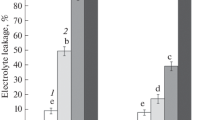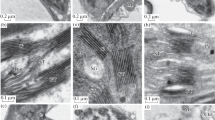Abstract
Frost hardiness of spinach (Spinacia oleracea L.) leaves was increased by high concentrations of NaCl in the hydroponic culture medium. Freezing damage was determined by measurement of slow chlorophyll fluorescence quenching after freezing of leaves. Both the osmolality of the leaf sap and forst hardiness of the leaves were linearly correlated with the salt concentration in the hydroponic culture medium. Freezing damage occurred, irrespective of the extent of frost hardening, when dehydration of cells during extracellular ice formation decreased cellular volume to approximately 14% of the volume of unfrozen cells. The resistance of isolated, washed thylakoids against mechanical and chemical damage by freezing was investigated. Chemical damage by freezing caused by salt accumulation was measured as release of chloroplast coupling factor (CF1; EC 3.6.1.3), and mechanical damage was measured as release of the lumenal protein plastocyanin from the membranes during an in-vitro freeze-thaw cycle. Isolated thylakoids from salt-treated frost-hardy spinach and those from plants hardened under natural conditions did not exhibit improved tolerance against chemical freezing stress exerted by high salt concentrations. They were, however, more hardy than thylakoids from unhardened control leaves against mechanical damage by freezing.
Similar content being viewed by others
Abbreviations
- CF1:
-
peripheral part of chloroplast coupling factor ATPase
References
Beck, E., Schulze, E.-D., Senser, M., Scheibe, R. (1984) Equilibrium freezing of leaf water and extracellular ice formation in Afroalpine “giant rosette” plants. Planta 162, 276–282
Coughlan, S.J., Heber, U. (1982) The role of glycinebetaine in the protection of spinach thylakoids against freezing stress. Planta 156, 62–69
Coughlan, S.J., Wyn Jones, R.G. (1980) Some responses of Spinacea oleracea to salt stress. J. Exp. Bot. 31, 883–893
Coughlan, S.J., Wyn Jones, R.G. (1982) Glycinebetaine biosynthesis and its control in detached secondary leaves of spinach. Planta 154, 6–17
Dowgert, M.F., Steponkus, P.L. (1984) Behavior of the plasma membrane of isolated protoplasts during a freeze-thaw cycle. Plant Physiol. 75, 1139–1151
Fowler, D.B., Hamm, J.W. (1980) Crop response to saline soil conditions in the parkland area of Sasketchewan. Can. J. Soil Sci. 60, 439–449
Gusta, L.V., Fowler, D.B., Tyler, N.J. (1982) Factors influencing hardening and survival in winter wheat. In: Plant cold hardiness and freezing stress, vol. 2, pp. 23–40, Li, P.H., Sakai, A., eds. Academic Press, New York London
Hincha, D.K., Heber, U., Schmitt, J.M. (1985) Antibodies against individual thylakoid membrane proteins as molecular probes to study chemical and mechanical freezing damage in vitro. Biochim. Biophys. Acta 809, 337–344
Hincha, D.K., Schmidt, J.E., Heber, U., Schmitt, J.M. (1984) Colligative and non-colligative freezing damage to thylakoid membranes. Biochim. Biophys. Acta 769, 8–14
Hincha, D.K., Schmitt, J.M. (1985) Mechnical and chemical injury to thylakoid membranes during freezing in vitro. Biochim. Biophys. Acta 812, 173–180
Kaiser, W.M. (1982) Correlation between changes in photosynthetic activity and changes in total protoplast volume in leaf tissue from hygro-, meso-and xerophytes under osmotic stress. Planta 154, 538–545
Kaiser, W.M., Weber, H., Sauer, M. (1983) Photosynthetic capacity, osmotic response and solute content of leaves and chloroplasts from Spinacia oleracea under salt stress. Z. Pflanzenphysiol. 113, 15–27
Klosson, R.J., Krause, G.H. (1981a) Freezing injury in cold-acclimated and unhardened spinach leaves. I. Photosynthetic reactions of thylakoids isolated from frost-damaged leaves. Planta 151, 339–346
Klosson, R.J., Krause, G.H. (1981b) Freezing injury in cold-acclimated and unhardened spinach leaves. II. Effects of freezing on chlorophyll fluorescence and light scattering reactions. Planta 151, 347–352
Krause, G.H., Klosson, R.J., Justenhoven, A., Ahrer-Steller, V. (1984) Effects of low temperatures on the photosynthetic system in vivo. In: Advances in photosynthesis research vol. 4, pp. 349–358, Sybesma, L., ed. Nijhoff/Junk Publishers, The Hague, Netherlands
Levitt, J. (1980) Responses of plants to environmental stresses 2nd ed., vol. 1, Kozlowski, T.T., ed. Academic Press, New York London
Mancini, G., Carbonara, A.O., Heremas, J.F. (1965) Immunochemical quantitation of antigens by single radial immunodiffusion. Immunochem. 2, 235–254
Meryman, H.T., Williams, R.J., Douglas, M.S.J. (1977) Freezing injury from “solution effects” and its prevention by natural or artificial cryoprotection. Cryobiology 14, 287–302
Robinson, S.P., Downton, W.J.S. Millhouse, J.A. (1983) Photosynthesis and ion content of leaves and isolated chloroplastis of salt-stressed spinach. Plant Physiol. 73, 238–242
Santarius, K.A. (1984) Effective cryoprotection of thylakoid membranes by ATP. Planta 161, 555–561
Santarius, K.A., Giersch, C. (1983) Cryopreservation of spinach chloroplast membranes by low-molecular-weight carbonhydrates. II. Discrimination between colligative and noncol ligative protection. Cryobiology 20, 90–99
Santarius, K.A., Giersch, C. (1984) Factors contributing to inactivation of isolated thylakoid membranes during freezing in the presence of variable amounts of glucose and NaCl Biophys. J. 46, 129–139
Schmitt, J.M., Schramm, M.J., Pfanz, H., Coughlan, S., Heber U. (1985) Damage to chloroplast membranes during dehydration and freezing. Cryobiology 22, 93–104
Schwab, K.B., Heber, U. (1984) Thylakoid membrane stability in drought-tolerant and drought-sensitive plants. Planta 161, 37–45
Siminovitch, D., Cloutier, Y. (1983) Drought and freezing tolerances and adaptation in plants: some evidence of near equivalences. Cryobiology 20, 487–503
Steponkus, P.L. (1984) Role of the plasma membrane in freezing injury and cold acclimation. Annu. Rev. Plant Physiol 35, 543–584
Sucoff, E., Hong, S.G., Wood, A. (1976) NaCl and twig dieback along highways and cold hardiness of highway versus garden twigs. Can. J. Bot. 54, 2268–2274
van Swaaij, A.C., Jacobsen, E., Feenstra, W.J. (1985) Effect of cold hardening, wilting and exogenously applied proline on leaf proline content and frost tolerance of several gene types of Solanum. Physiol. Plant. 64, 230–236
Wolter, F.P., Schmitt, J.M., Bohnert, H.J., Tsugita, A. (1984) Simultaneous isolation of three peripheral proteins — a 32 kDa protein, ferredoxin NADP+ reductase and coupling factor — from spinach thylakoids and partial characterization of a 32 kDa protein. Plant Sci. Lett. 34, 323–334
Author information
Authors and Affiliations
Rights and permissions
About this article
Cite this article
Schmidt, J.E., Schmitt, J.M., Kaiser, W.M. et al. Salt treatment induces frost hardiness in leaves and isolated thylakoids from spinach. Planta 168, 50–55 (1986). https://doi.org/10.1007/BF00407008
Received:
Accepted:
Issue Date:
DOI: https://doi.org/10.1007/BF00407008




